nando
valued member
Posts: 16 
|
Post by nando on Nov 15, 2017 22:14:07 GMT
|
|
nando
valued member
Posts: 16 
|
Post by nando on Nov 16, 2017 9:33:41 GMT
To be a bit more precize. Are Wima mks4 0,22uF a good choice? These are metalized polyester (pet) versions.
I read non metalized film capacitors are better than metalized versions.
|
|
solderdude
Administrator
measureutternutter
Posts: 4,886
|
Post by solderdude on Nov 16, 2017 19:11:36 GMT
Hi Nando,
Personally I would only replace electrolytic caps.
The film caps are fine and do not age in this application.
These are decoupling caps.
They do their work very high above the audible range.
If they were in a switching circuit (power regulators etc.) there might be a reason to change the film caps as then they would have 'aged'.
Not all wirewound resistors have a high inductance.
Some are bifilar wound and have very low inductance.
The green resistors consist of about 5 to 6 windings.
The core is ceramic so won't increase inductance.
The inductance is probably around 0.1uH or something.
A piece of wire of the same length won't have much more inductance.
There may be some measurable influence in circuit (not on the LS out) above 1MHz or so.
I suspect the output devices are more limited in frequency response than these resistors.
These are in not directly in series with the output but are in the power supply line followed by the output device.
Essentially in series but not exactly.
3 of these are essentially in parallel so the inductance in series with the power supply is about 3 times lower in the output circuit.
perhaps around 30nH which are in series with 3 others sort of in parallel making it around 60nH.
Consider the following.
That small inductance is basically in series with the output series inductor L1 which will be >10uH.
L1's inductance is 'damped' by a 3.3 Ohm parallel resistor.
The value of L1 is bigger than that of wirewound resistors.
So replacing them with carbon/plastic film or other non-inductive resistors won't do much if anything because the series inductance is way bigger.
Of course you could replace them if you want.
I am 100% convinced that when you feel it would/could make an audible difference it will.
Consider that L1 is in series with LOTS of windings of the tweeter you connect it too.
Not to mention the X-over for woofer/midrange.
L1 is part of the Boucherot filter along with resistors and caps around it.
The 0.22 uF cap is also part of that filter and has no influence on the output signal.
It is there to 'short' frequencies >100kHz to ground.
As said, if it were my amp and would be overhauling it the electrolytics would be replaced and would have a look into capacitors directly in the signal path.
coupling caps on the input perhaps.
I am not a capacitor believer...
What I am for though is using the right capacitors in the right application/circuit.
I don't think MF made poor choices in components (caps, resistors, semiconductors, aside perhaps from the electrolytic caps.
|
|
nando
valued member
Posts: 16 
|
Post by nando on Nov 16, 2017 20:44:45 GMT
Thanks for your reply. By the way I don't have tweeters, I have two Quad esl63s. I know about the placebo effect. It's quite difficult to test the result of a mod only by hearing and impossible before and after a long soldering session. I didn't believe all the people who modded their electronics. But after overhauling half of my x-series MF cans I am sure changing components makes a difference. Luckily it was an improvement so far. I mostly changed the elco (yes, I'm Dutch) and valves so far. Bass got better defined. MF choose Jamicon of Teapo electrolytic caps for all of these electronics of this series. These caps aren't the worst choice but also not the best one can get. I found a handfull of high esr caps. I replaced them (in other MF stuff) with Panasonic FR, EE, Nichicon LGN, UEP, UVP and UKW. These 0,22uF film caps are after the transformer at the power supply side of the amp. Would these be coupling caps on the input like you mentioned? 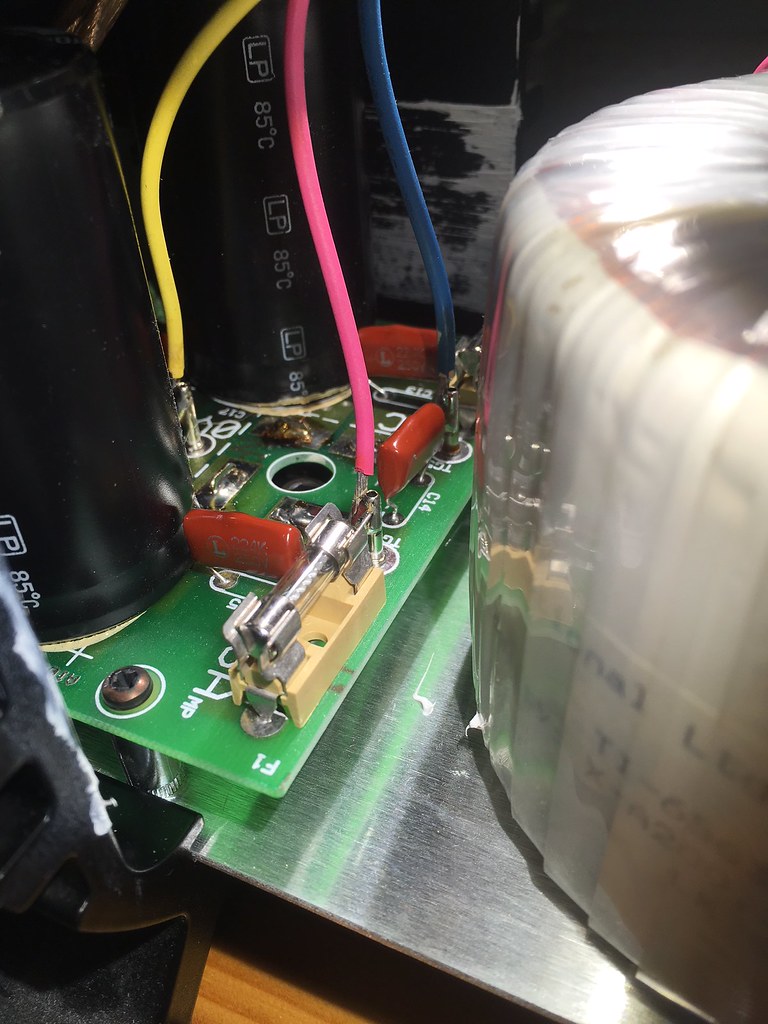 |
|
Crispy
very active
Madrigal music is playing - Voices can faintly be heard, "Please leave this patient undisturbed."
Posts: 779 
|
Post by Crispy on Nov 16, 2017 21:35:47 GMT
Hi Nando, Personally I would only replace electrolytic caps. The film caps are fine and do not age in this application. Hi Nando welcome to the forum, listen to Frans he is a genius with everything to do with electronics  I upgraded my mono amps a couple of years ago - not without problems and would never have got them going again without the help of Frans. Some pics Before I started: 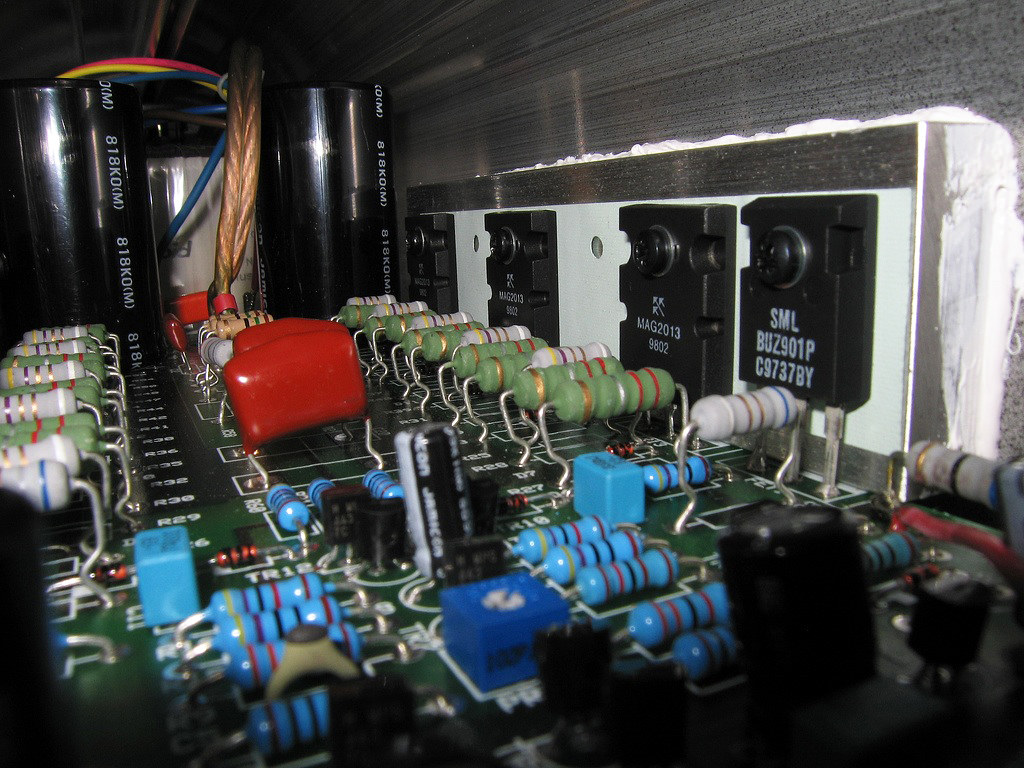 Before Before by
After (finished)
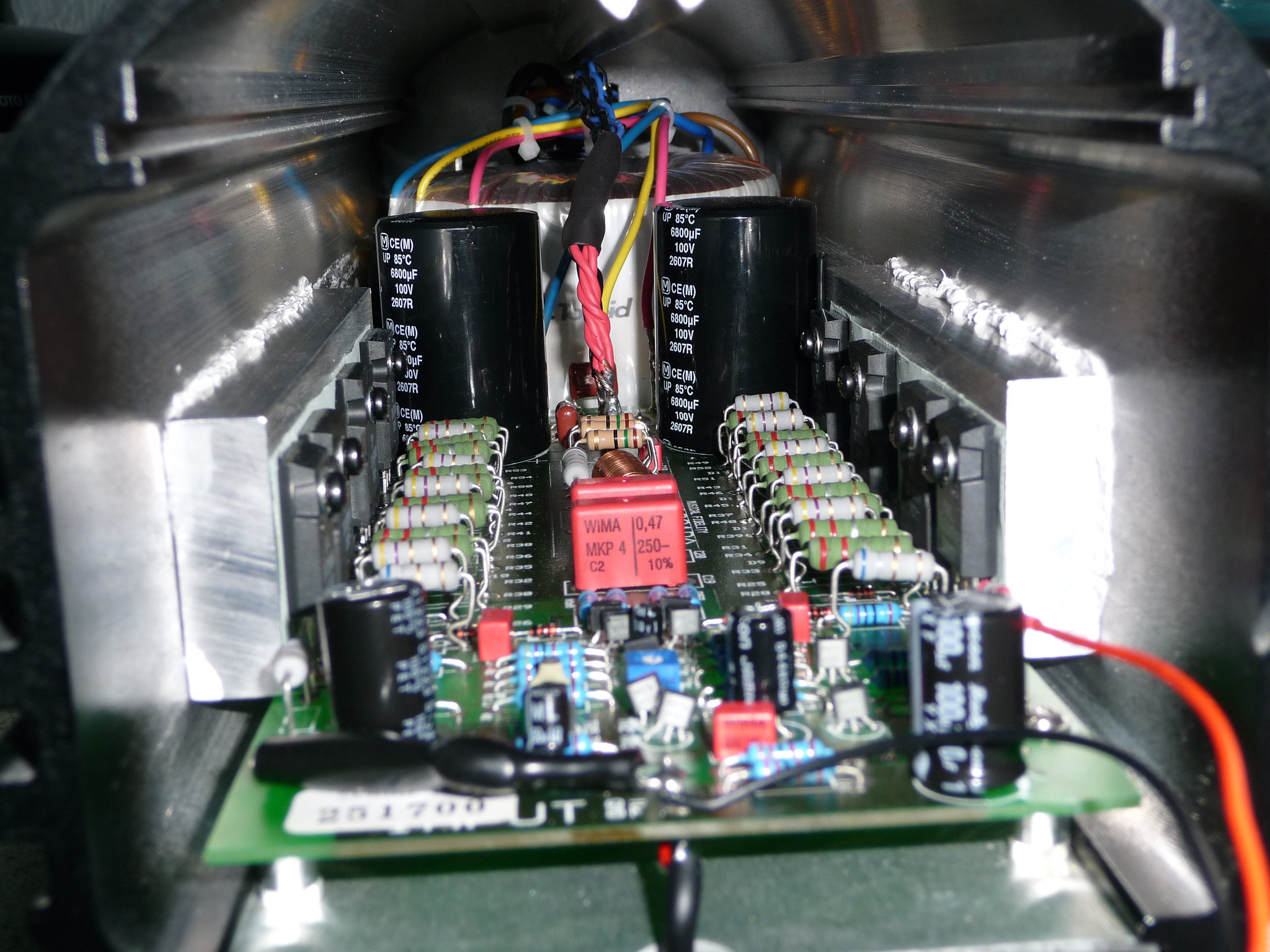 I would on reflection, only change the elctrolytic caps and save yourself some work. I would definitely NOT go to all the bother to replace the resistors. I changed things like wire to OFC, I also changed the red and blue caps on the board but would not do so again. I also changed the stock wire to Kimber OFC: 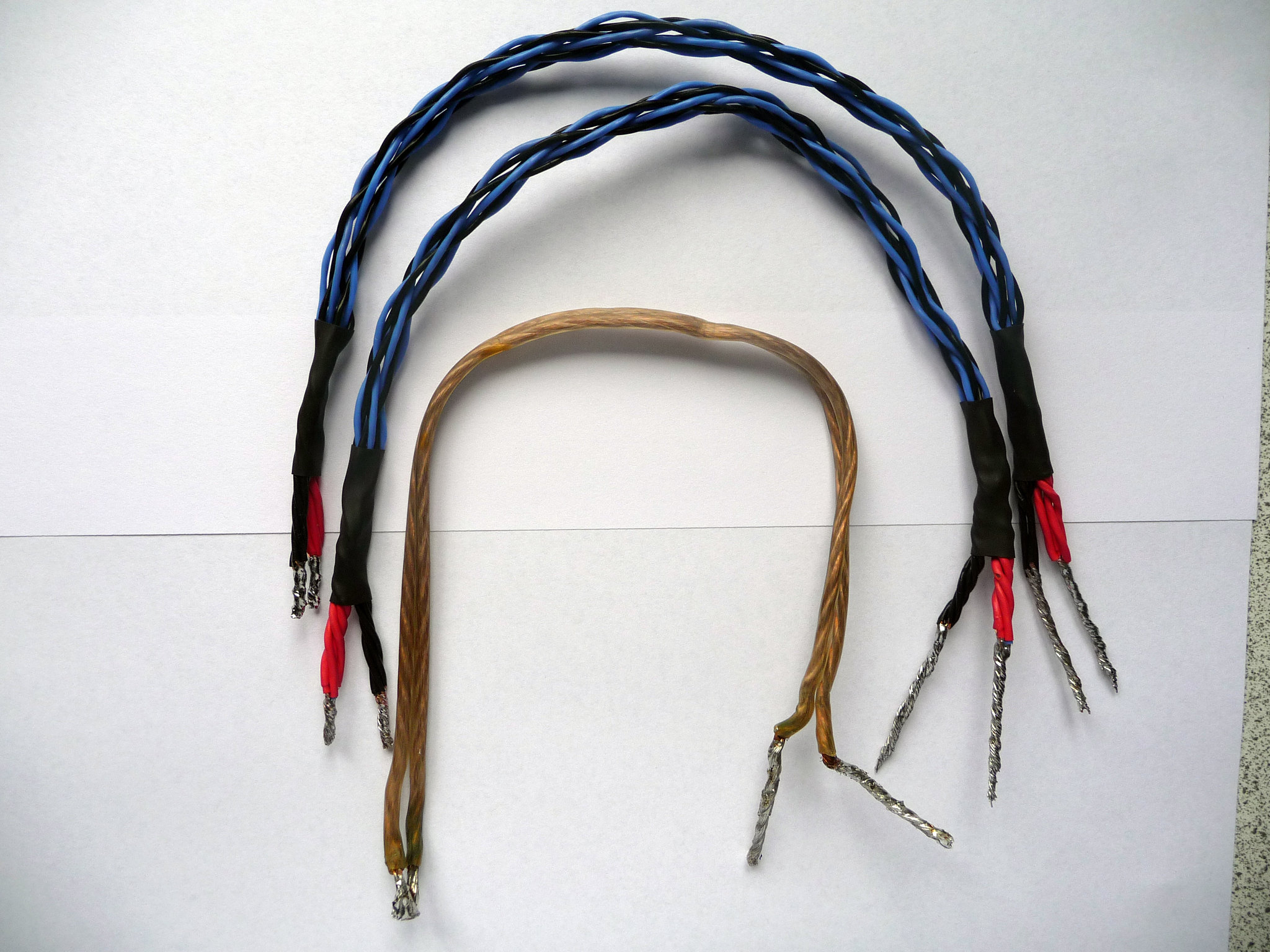 Jamicon 6800uf caps to Panasonic 6800uf caps. 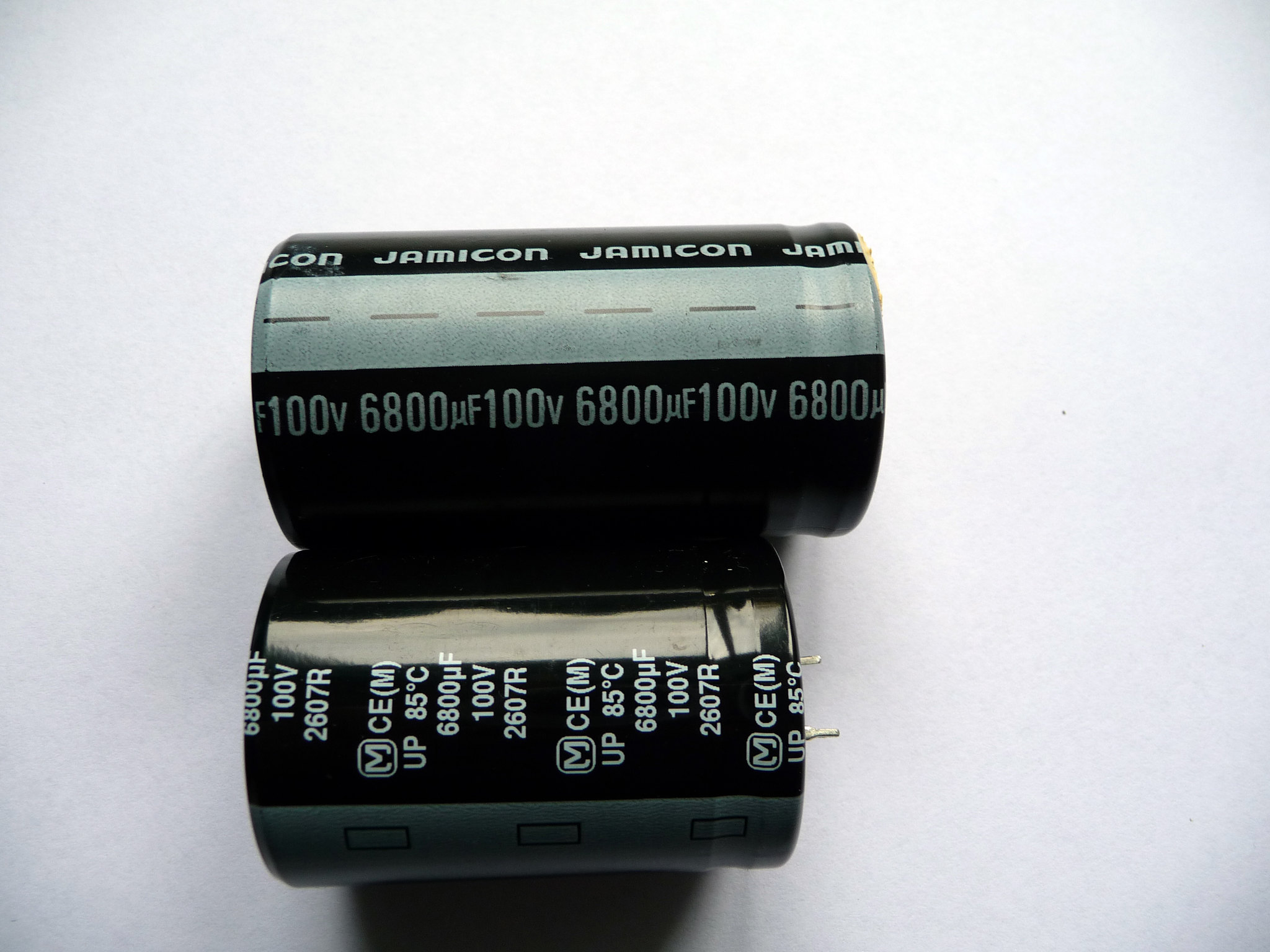 They are brilliant amps and well worth upgrading, but listen to Frans he will save you a hell of a lot of time and money? |
|
solderdude
Administrator
measureutternutter
Posts: 4,886
|
Post by solderdude on Nov 16, 2017 21:43:22 GMT
Those caps (most likely, can't see from the picture) are decoupling caps as well. Just like the 470nF on the amp board. Most likely all coupling caps (the ones that block DC in the audiopath) are all electrolytics in this amp. I suspect C14 may be in parallel to the 'hot' transformer windings. The other 2 MAY be between the hot AC parts of the trafo and the CT (Centre Tap) or ground. For so called 'snubber' capacitors these would be too big in value. For AC caps, filtering AC noise the values are more suited. The question when overhauling old amps with dried out caps is whether or not the increase in SQ comes from (almost) faulty caps being replaced by 'fresh' caps or better suited caps or the fact that in most cases parts are increased in values (certainly with X-type stuff). Most likely, when the same values and type of caps were used an improvement may well be experienced as well given the fact performance MAY increase due to the old parts being out of spec. I, for one, don't trust my ears as analyzers. That's where measurement equipment excells. Certainly when some time has passed, or even worse, days. I do trust my ears to determine whether I like music or SQ and trust my ears more than those of others in the sense that I have my own preference. You can PM me in Dutch with specific questions if needed. Ah yes, great speaker. Very difficult to drive and potentially amp killers when the 'spark' protection kicks in when putting too much power in it. The transformer in the ESL also has a LOT higher inductance than L1. In the ESL63 the higher frequencies are a bigger problem which can cause some amps to become unstable due to the high capacitive load it is. L1 in this amp is specifically there to 'counter' this problem. Have Stats too but they are home made and out of service since kids and cats. These are unique in the sense that the membrane is not tensioned. All other stats have tensioned membranes. |
|
nando
valued member
Posts: 16 
|
Post by nando on Nov 16, 2017 22:08:02 GMT
Ah, I see I've come to the right place. Why haven't I found this before?
My esl-63 "killed" one of my MF a-200 amps before I bought them. I got the esl second hand from a shop to try and loved it and the shop repaired the amp. No problems ever since.
How is it difficult to drive? I heared someone else say that a few months ago but he could explane.
|
|
solderdude
Administrator
measureutternutter
Posts: 4,886
|
Post by solderdude on Nov 16, 2017 22:25:59 GMT
These speakers are 'difficult' to drive for 3 reasons.
1: the low 'impedance' it has. This means an amp needs to be able to provide a lot of current.
2: The protection circuit in the ESL (against sparking and overload) is designed to almost 'short' the output of the amp effectively reducing the power output of said amp.
The Quad amps have current limiters inside which simply limit the power.
These stats are purpose built to work perfectly on Quad amps.
Amps with no shortcircuit protection (such as A200) thus can be destroyed as the current is not limited.
Many power amps have this problem but not all
3: ESL's are capacitors. The transformer transforms these capacitors in huge value capacitors.
Speakers are inductors.
Magnetostats are more resistive.
When driving a highly capacitive speaker (or highly inductive) the current and output voltage do not have the same phase.
To charge a capacitor a LOT of current is needed to reach another voltage.
With inductive speakers the voltage is easily changed and the current increases when the voltage is applied.
When a signal starts (or goes through the 0V line as it is AC) the output devices are essentially 'off' yet have to provide a LOT of current so they should not be really off but be able to provide current when there is no output voltage.
Not all amps do this well.
With inductive speakers the current comes after a voltage change.
With capacitive speakers the current is needed before a voltage change.
These issues make stats difficult to drive.
But not impossible.
There are plenty of amps fully capable of doing this.
Just not all amps.
Those less suited amps may be perfectly able to drive 'dynamic' speakers though.
|
|
nando
valued member
Posts: 16 
|
Post by nando on Dec 6, 2017 9:42:21 GMT
As of yet I was able to drive the esl-63 with three amps.
Marantz pm80mkII
Musical Fidelity X-A200 mono power amps
Sony TA-N 220 power amp.
Maybe I was lucky?
Is there a way to make a protection circuit between the esl and an amp?
I really don't want to blow up my x-a200 amps.
|
|
solderdude
Administrator
measureutternutter
Posts: 4,886
|
Post by solderdude on Dec 6, 2017 9:53:23 GMT
As long as you do not reach levels where the spark protection kicks in and the amps can drive 4 Ohm and don't mind a capacitive load it is no problem to drive it.
The only way to protect the amp is to incorporate a current limiter in that design when it does not have any.
Fuses and relays all will react too slow.
Another way would be to disable the spark protection in the ESL.
Assuming that is what killed the amp that is.
Also possible the amps design itself is what killed it or a part that simply gave up.
|
|
nando
valued member
Posts: 16 
|
Post by nando on Dec 6, 2017 21:10:52 GMT
I saw a review of my power amps (xa200) that says that these amps can deliver 200W at 8ohm, 400W at 4ohm and 500W at 2 ohm.
So that should be enough I guess.
The protection is not so easy as I would like. Oh, well, hope it doesn't spark anytime soon.
I don't play at loud volumes.
|
|
nando
valued member
Posts: 16 
|
Post by nando on Dec 20, 2017 11:08:23 GMT
I have replaced the capacitors with fresh ones. I searched on Mouser for the highest ripple current I could find from top brands. I bought Nichicon's and the big ones from CDE. The 6800uF were replaced with 10.000 uF CDEs and all the other with same capacitence capacitors (try saying those two words five times fast) from Nichicon. I didn't bother replacing anything else because of the advice of you guys. Saves me time and money. Money (and some more) which was spend on an oscilloscope. It underwent a dry test (no speakers) and is undergoing a test with speakers. She runs fine. What a nasty stuff this cooling paste is. Scraped the paste and replaced it evenly on the three places it is supposed to be. 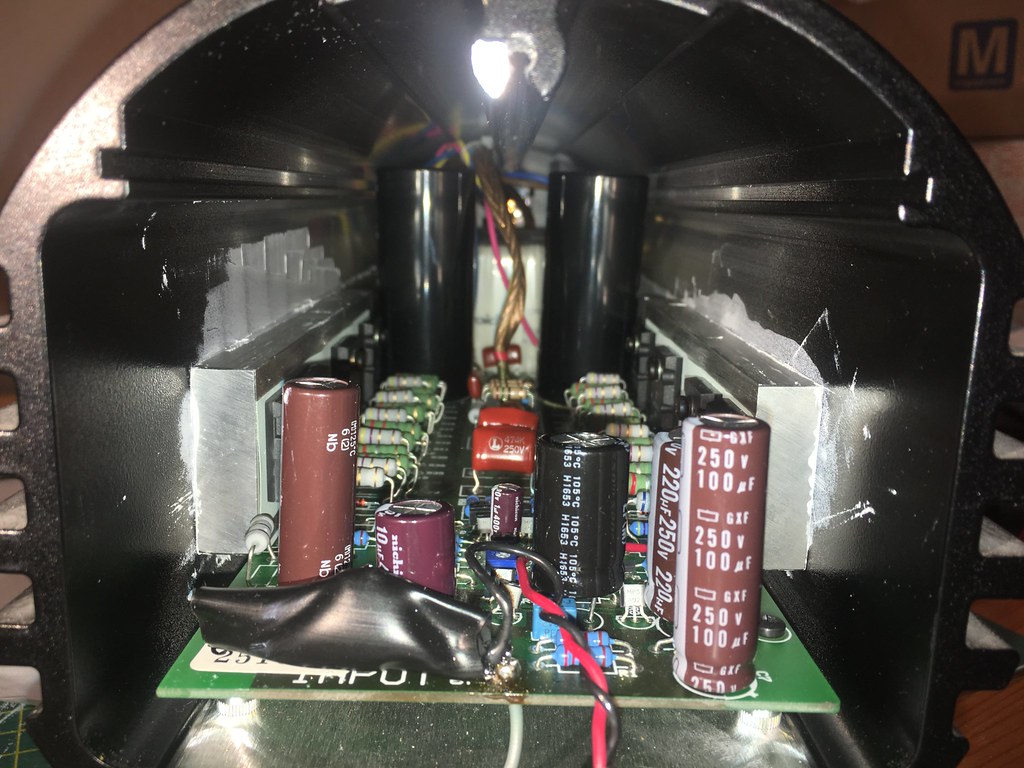  Underside of the rectifierbridge with cooling paste. 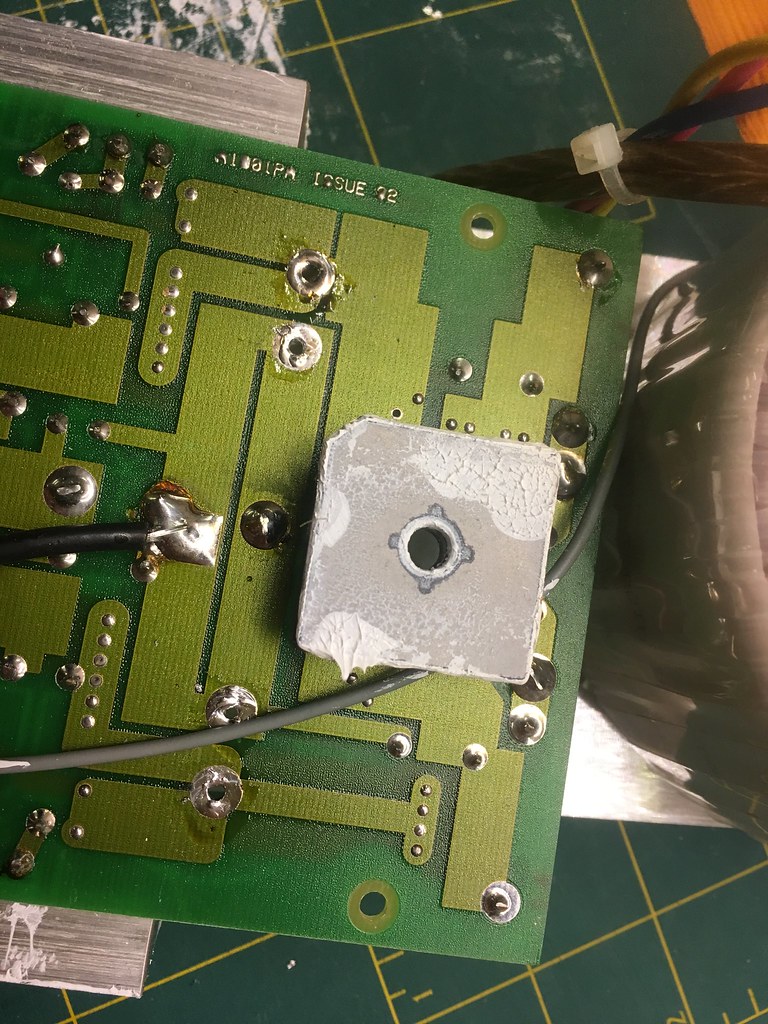 The old big capacitors.  |
|
solderdude
Administrator
measureutternutter
Posts: 4,886
|
Post by solderdude on Dec 20, 2017 11:35:41 GMT
cooling paste on your clothes is pretty hard o wash out again.
On the fingers it will wear off.
Use as little as possible.
Apply some of the stuff and scrape the excess off with an old unused credit card alike card.
It is not needed when using the silicone pads (between the power devices and the alu heatsink bar)
|
|
nando
valued member
Posts: 16 
|
Post by nando on Dec 20, 2017 13:38:30 GMT
cooling paste on your clothes is pretty hard o wash out again. On the fingers it will wear off. Use as little as possible. Apply some of the stuff and scrape the excess off with an old unused credit card alike card. It is not needed when using the silicone pads (between the power devices and the alu heatsink bar) I wore an aprin to protect my clothes and washed my hands thoroughly. I wonder how the cooling paste is applied in the factory because if you slide the pcb in the coolingpaste is smeared along the the inside of the casing. But new the amp doesn't have the coolling paste smeared. There is no room to clean the inside so my guess is the cooling paste is applied on the laste stage of assembly or the coolingblock is at an angle inwards when the pcb is shoved in the casing. I didn't unscrew the powertransistors so I didn't remode the silicone (didn't know that) pad. |
|
Coop
valued member
Posts: 3
|
Post by Coop on Dec 11, 2019 13:39:57 GMT
Hi Nando, Personally I would only replace electrolytic caps. The film caps are fine and do not age in this application. Hi Nando welcome to the forum, listen to Frans he is a genius with everything to do with electronics  I upgraded my mono amps a couple of years ago - not without problems and would never have got them going again without the help of Frans. Some pics Before I started:  Before Before by
After (finished)
 I would on reflection, only change the elctrolytic caps and save yourself some work. I would definitely NOT go to all the bother to replace the resistors. I changed things like wire to OFC, I also changed the red and blue caps on the board but would not do so again. I also changed the stock wire to Kimber OFC:  Jamicon 6800uf caps to Panasonic 6800uf caps.  They are brilliant amps and well worth upgrading, but listen to Frans he will save you a hell of a lot of time and money? Crispy/Solderdue, I noticed that you populated the two spare transistor openings on the board. Did this make any difference to the sound? I have extensively read your other post 'Musical Fidelity XA200 Repair' where solderdude thought that it wouldn't but would help against accidental shorting of the amp. When it comes to replacing old dry electrolytic caps on the board does anyone have a full list of the values per mono amp? I can see some in the very detailed pics on the forum posts, but not all are visible. Is it worth looking for caps of the same value or is it worth upgrading the values of any when replacing? Does anyone recommend certain manuf's and model of cap? In my set up I use a MF X-A2 integrated and the two X-A200 mono's in a passive bi-amped setup. The stereo power section of the 75wpc X-A2 drives the tweeters as well as the pre-amp section. Then each X-A200 mono drive's the bass unit of my two-way ATC speakers. Any thoughts on this? Could I better the setup by getting rid of the X-A2 and going pre-amp plus the two X-A200 and then just single runs of speaker wire to the ATC's and so using the ATC X-over (instead of the current doubling up of speaker wire between the X-A2/X-A200'a and the speakers? |
|